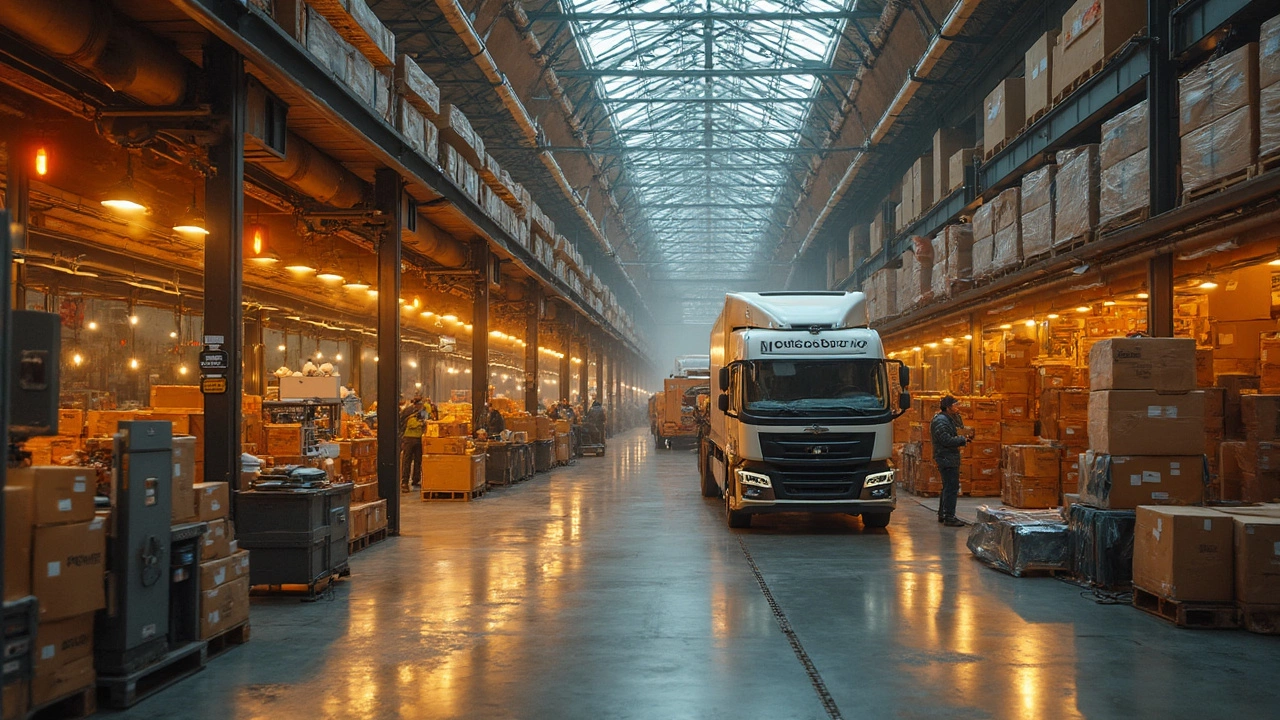E-commerce isn't just about getting customers to click the 'buy' button; it's also about ensuring their purchase reaches them swiftly and safely. This is where logistics comes into play. At its core, logistics is the backbone of e-commerce, and without it, even the best online stores would falter.
Logistics isn't just about moving products from point A to point B; it's about managing an entire supply chain efficiently. From warehousing and inventory management to last-mile delivery, every step has to sync perfectly to keep customers happy.
Did you know that nearly 60% of consumers say that their delivery experience directly affects their brand loyalty? That's why it's essential not only to focus on the front-end of e-commerce but also to give logistics the attention it deserves. When you get logistics right, everything from customer satisfaction to repeat purchases can improve.
- Why Logistics Matters in E-Commerce
- The Role of Technology in Modern Logistics
- Challenges and Solutions in E-Commerce Logistics
- Tips to Optimize Your E-Commerce Logistics
Why Logistics Matters in E-Commerce
In the world of e-commerce, logistics is the silent hero. Think of it as the hidden engine that ensures packages reach your doorstep on time. It's the oil that keeps the e-commerce machine running smoothly. But why is it so crucial? Let's break it down.
The Backbone of Customer Satisfaction
When you order something online, the clock starts ticking. The speed and accuracy of delivery can make or break the customer experience. A study by MetaPack a while back noted that 85% of customers won't return to a retailer after a bad delivery experience. That's a lot! This means businesses can't afford to overlook the logistics aspect if they want to keep customers coming back.
"E-commerce grows with the efficiency of its logistics." - MetaPack Study
Efficiency and Cost Management
Smart logistics planning leads to cost saving. By optimizing supply chains, businesses can lower shipping costs and improve margins. This is especially important for small to mid-sized online retailers fighting against giants like Amazon. Every penny saved means better prices or more tools to reinvest into the business.
Handling Returns and Exchanges
Not every sale goes perfectly. Sometimes customers need to return items and here's where logistics shines again. A well-organized returns process can turn a return into an opportunity to build trust and showcase great service. It might seem like a small thing, but this can differentiate you from your competitors.
Using Technology to Enhance Logistics
Technology plays a huge role in modern logistics. From tracking systems providing real-time updates to AI predicting the best routes, technology makes logistics smarter and more reliable. Large retailers often use a combination of drones, AI, and blockchain to make logistics seamless, setting a version of 'gold standard' in the industry.
| Impact | Percentage |
|---|---|
| Customers Unsatisfied with Late Delivery | 60% |
| Repeat Purchases after Timely Delivery | 75% |
Without logistics, you'd be hard-pressed to get your goods from warehouse to customer. It's that simple. By focusing on logistics, retailers ensure happy customers, efficient operations, and a competitive edge in the crowded e-commerce field.
The Role of Technology in Modern Logistics
Technology is reshaping how e-commerce businesses approach logistics, and it's a game-changer in this space. From automating routine tasks to providing real-time data insights, technological advancements are making logistics smarter, faster, and more efficient.
Automation and Robotics
One of the most groundbreaking shifts is the use of automation and robotics in warehouses. These technologies streamline operations by managing sorting, packing, and even inventory checks more efficiently than ever before. By reducing human error and speeding up processes, businesses can handle more orders while maintaining accuracy.
Advanced Inventory Management
Modern logistics thrives on data, and advanced inventory management systems provide just that. These systems help businesses keep track of stock levels in real-time, predict demand fluctuations, and avoid overstocking or stockouts. This way, orders can be fulfilled promptly, enhancing customer experience.
Integrated Platforms
For e-commerce businesses, integrating logistics platforms is crucial. Systems like Order Management Systems (OMS) and Transport Management Systems (TMS) merge various aspects of the supply chain, ensuring that everything runs smoothly from the warehouse to the customer's doorstep. This integration improves visibility and coordination across the board.
Real-Time Tracking and Data Analytics
Real-time tracking technology allows customers and businesses to monitor shipments at every step. This visibility not only increases trust but also helps in quickly resolving any unforeseen issues. Besides, data analytics play a critical role; by analyzing delivery patterns and customer behaviors, firms can fine-tune their logistics strategies for optimal results.
Internet of Things (IoT) and Connectivity
The Internet of Things (IoT) has introduced a new level of connectivity to logistics. With IoT sensors, companies can monitor their fleets in real-time, track environmental conditions like temperature and humidity, and ensure the integrity of their products during transit.
| Technology | Impact on Logistics |
|---|---|
| Robotics | Increased efficiency and reduced errors |
| Data Analytics | Improved decision making |
| IoT | Enhanced tracking and monitoring |
As technology continues to evolve, the synergy between e-commerce and logistics will only strengthen, setting new standards in delivery speed, accuracy, and customer satisfaction. Businesses that leverage these technologies effectively will undoubtedly stand out in the competitive online marketplace.

Challenges and Solutions in E-Commerce Logistics
Navigating the world of e-commerce logistics comes with its fair share of hurdles. Let’s break down the main challenges and offer some practical solutions.
Challenge 1: Managing Last-Mile Delivery
Last-mile delivery is the final step in the logistics process, but it's often the most difficult and expensive. Urban congestion, remote locations, and customer availability are just a few wrench-throwers in the gears.
- Solution: Leverage local courier networks and flexible delivery windows. Another approach is using technology like real-time tracking and route optimization to streamline this tricky stage.
Challenge 2: Inventory Management
Keeping track of stock to avoid overstocking or running out is a classic headache. Miss this step, and you're risking both sales and customer satisfaction.
- Solution: Implement smart inventory systems that use data analytics to predict trends, allowing you to optimize your stock levels seamlessly.
Challenge 3: Handling Returns Efficiently
Returns can be a logistical nightmare and often feel like they’re eating into profits.
- Solution: Create a clear returns policy and use it to set up a streamlined process. Consider reverse logistics technology to handle returns smoothly and even turn them into an opportunity to impress customers.
Challenge 4: Meeting High Customer Expectations
Today’s customers are a demanding bunch, expecting fast shipping and perfect conditions.
- Solution: Communication is key. Provide clear delivery timelines and keep customers in the loop with tracking updates. An honest approach goes a long way in maintaining trust.
Real-World Data
Check out this quick snapshot to understand why getting these elements right matters:
| Aspect | Impact on Customer Satisfaction |
|---|---|
| Fast Delivery | 70% increase in satisfaction |
| Easy Returns | 63% improved loyalty |
In the end, tackling logistics challenges is all about smart planning and embracing technology. Stay ahead with these strategies, and watch your e-commerce business thrive.
Tips to Optimize Your E-Commerce Logistics
Getting your e-commerce and logistics humming together doesn't happen by accident; it requires a keen approach. Here are some actionable tips to keep things running smoothly.
Streamline Your Supply Chain
It's essential to know where every product is at any given time. Use tools that help in managing inventory efficiently. Software solutions can offer real-time updates and manage stock levels to prevent over or under-stocking.
Invest in Technology
Technology is your best friend when it comes to logistics. Consider adopting systems like Warehouse Management Systems (WMS) or Transportation Management Systems (TMS) for greater accuracy and efficiency.
- WMS: Helps in managing warehouse operations such as picking, packing, and inventory tracking.
- TMS: Optimizes route planning, transportation costs, and improves delivery performance.
Choose Reliable Delivery Partners
Your delivery services are an extension of your business. Choose partners known for reliability and speed. A well-regarded courier can make a massive difference in customer satisfaction. Plus, offering multiple delivery options never hurts.
Utilize Data for Forecasting
Use data from sales and inventory to forecast demand more accurately. This way, you can better prepare for peak times and reduce bottlenecks. Data can also help identify which products move faster and need prioritized transport.
| Aspect | Impact |
|---|---|
| Inventory Management | Reduces overhead by 20% |
| Technology Adoption | Increases delivery speed by 15% |
Optimizing logistics is more than just moving things quickly; it's about making smart choices every step of the way. By focusing on these core strategies, you can significantly enhance your e-commerce operations and deliver outstanding experiences to your customers.


